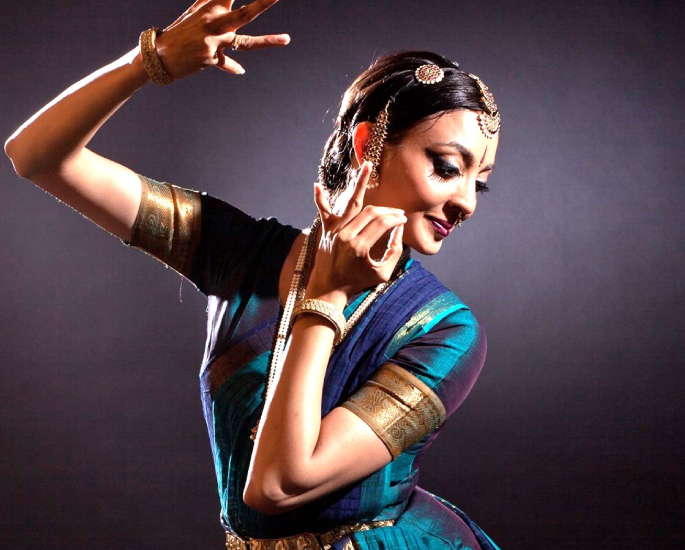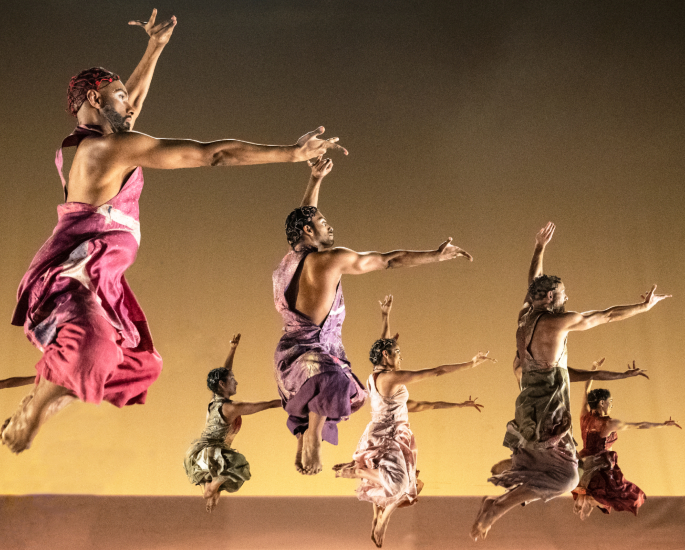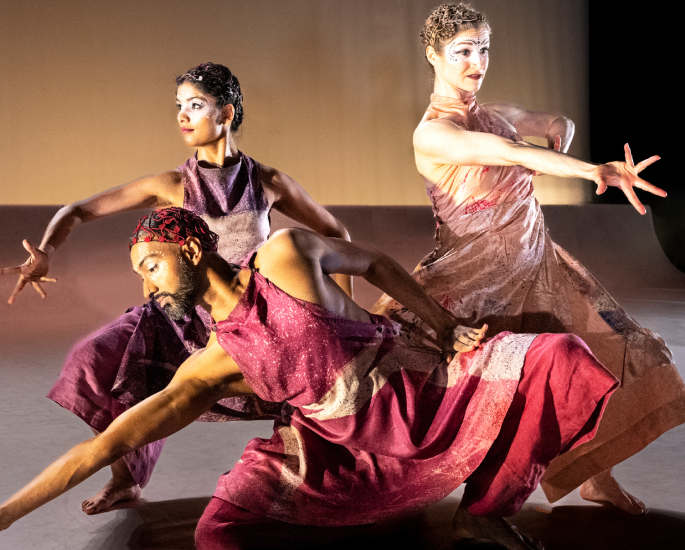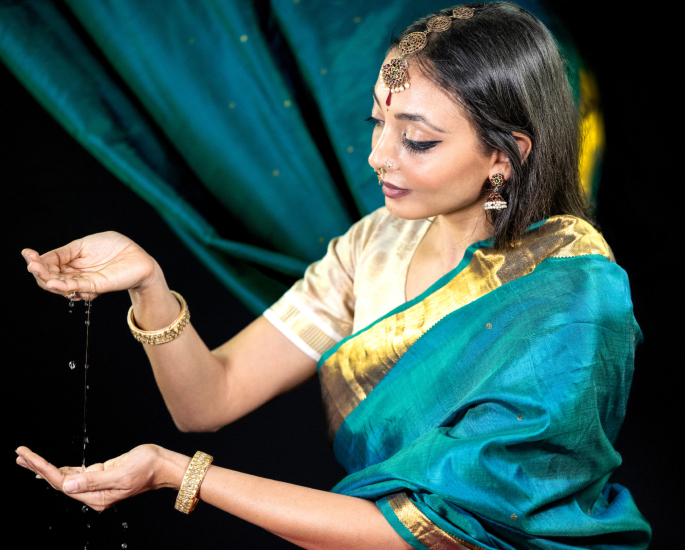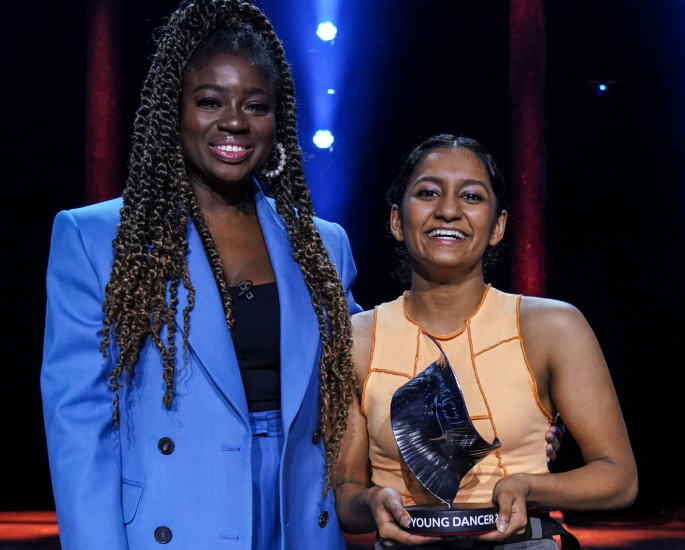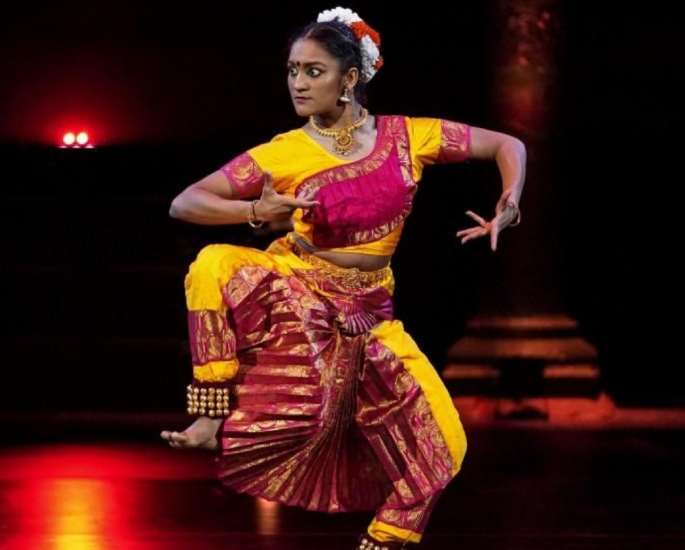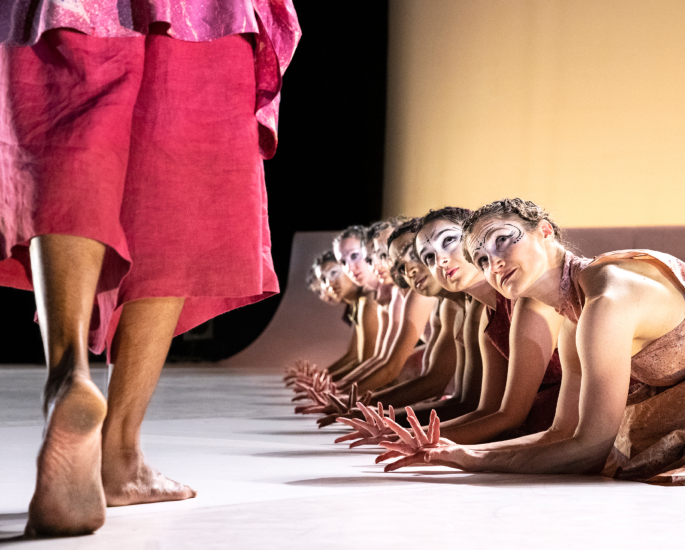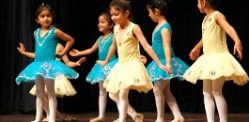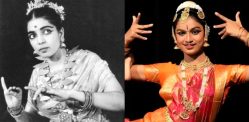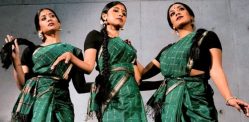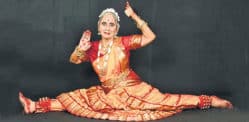"Seeta’s choreography lets us feel like we can fly"
In the world of dance, luminaries such as Seeta Patel and Adhya Shastry stand as shining stars, each with their unique brilliance.
Now, they are set to dazzle audiences across the UK with a production that transcends boundaries and redefines the art of dance.
Seeta Patel, an award-winning dancer and choreographer, has long been celebrated for her contributions to the world of Bharatanatyam.
The classical Indian dance form is known for its intricate footwork, geometric movements, and emotional depth.
Her illustrious career has taken her to prestigious stages such as London’s Southbank Centre, Royal Opera House, and Sadler’s Wells.
But Seeta Patel is not content with simply following tradition; she is a trailblazer, a visionary, and a creator of extraordinary narratives.
Joining her on this incredible journey is none other than Adhya Shastry.
The rising star has been on everyone’s minds since her remarkable victory at BBC’s Young Dancer competition in 2022.
Adhya’s dance prowess, coupled with her innate ability to captivate hearts, has made her a sensation in the world of contemporary dance.
Her talent knows no bounds, and her inclusion in this production marks a significant turning point in her burgeoning career.
Together, Seeta Patel and Adhya Shastry are on the verge of unveiling something extraordinary.
A tour de force that promises to blend the rich heritage of Bharatanatyam with Stravinsky’s iconic score, The Rite of Spring (ROS).
This collaboration transcends boundaries, weaving together two distinct dance traditions, and promises to be a groundbreaking fusion that will mesmerise viewers.
Join us as Seeta Patel and Adhya Shastry chat to DESIblitz about their contrasting journeys, The Rite of Spring, and the power of dance.
Seeta Patel
How did you approach the challenge of merging Bharatanatyam with Stravinsky’s score?
I have always preferred solo Bharatanatyam but I wanted to challenge myself to create ensemble work within the Bharatanatyam form.
When I initially decided to create an excerpt of The Rite of Spring I began to break the music into patterns that I could understand and related to the way we count in Bharatanatyam.
As the work developed I used this method to break down the entire music score.
This let me see how I could bring Bharatanatyam into the work musically.
It subsequently laid the groundwork for me to draw out the narrative and theatricality of the work.
The initial meeting point between dance and music was definitely the rhythmic aspect of the score.
Why choose Bharatanatyam to be performed in an ensemble?
I have seen ensemble Bharatanatyam work over the years, but I didn’t find myself connecting with it for various reasons.
So, I wanted to challenge myself to see if I could create something within the dance form in a group format that would excite me.
I thought I would just experiment by creating a few different excerpts of works in the ballet and contemporary dance world that are often created for many bodies.
“This allowed me to try out some different ideas and The Rite of Spring was most compelling.”
It was clear to me that I wanted to create the work in its entirety.
What’s the creative process behind the ‘Chosen One’ character?
The original narrative of The Rite of Spring was based on an individual (The Chosen One).
It was identified by the elders of the community who then danced themselves to death in order for Spring to come.
I approached my version with the idea of the community identifying The Chosen One and then elevating them to a deity.
After, the community submits and ultimately sacrifices themselves to their Chosen One.
The work culminates with the community retreating into The Chosen One in a reverse birth (in order for the whole cycle to begin again).
This cyclical approach felt more authentic to my upbringing and roots.
How do you blend Bharatanatyam with innovations for wider appeal?
I don’t approach my work with the idea of appealing to more people.
I do feel Bharatanatyam is a beautiful art form, and I hope to offer it to audiences in the best way I can.
So, I hope that this approach allows me to be authentic, and also take away the pressure of trying to please everyone.
“I think it is a matter of taste if people like something or not.”
And, I hope I can present work that at the very least piques the interest of those new to the form so they might like to see or know more about it.
I like to keep coming back to what the core of Bharatanatyam is to me (as a dancer and choreographer) and finding what I can do to push at the edges and maintain the DNA of the vocabulary.
It’s a very personal approach and journey for anyone working within such a long-standing and deeply cultural form.
It can be a scary and contentious space to work in.
But I do get joy in trying to express my ideas through the dance style I have been practicing since childhood.
How did you work with the orchestra to synchronise the moves?
The process of bringing 12 dancers together has been a challenge in itself. A lot of preparation was required.
This included understanding the limitations of working with a large and prolific orchestra.
The Bournemouth Symphony Orchestra (BSO) is one of the UK’s main orchestras.
They have a packed schedule of activity, as well as their principal conductor, Kirill Karabits, is a highly sought-after and respected artist in his own right.
This meant that time with the orchestra was limited so preparation was key.
The dancers and I worked with a recording (by the BSO) of the piece so we were as ready as possible.
I also spent some time with Kirill before working with the dancers to discuss some of the nuances of the tempo and accents in the music.
So, we were on the same page about what we needed and what the music needed to be able to shine.
When we did come together it was exciting for the musicians and the dancers to experience each others’ art after such a long journey to get to that point.
It was incredible.
What kind of reactions have you received from audiences so far?
I have been bowled over by the response to the work.
From both within the South Asian community and the wider audience it was clear the work spoke to people across the cultures.
The excitement in the auditorium at Sadler’s Wells was electric.
Young South Asian dancers came in full force to the show and I received a lot of great feedback and a real sense of something special for us all.
Seeing a 12-strong cast of Bharatanatyam dancers on such a prestigious stage accompanied by a formidable orchestra is not something that is seen very often.
“There was a real sense of something seminal in our field being reached.”
The response from the mainstream press was also amazing and really exciting that the work has been acknowledged in a wider context.
The Rite of Spring has been interpreted by many choreographers over many years.
This meant it was a daunting task to try my hand at it, so it was incredible that my version garnered much critical success.
In terms of my artistic vision from this point onwards, I would love the work to be seen all over the world.
I’m looking forward to the next works I make with their roots in my Bharatanatyam background.
What have been the standout moments in your 20-year career so far?
That’s an overwhelming thing to think about as there have been so many highs and so many lows.
Two decades feels like a generation shift. I’ve travelled the world dancing in some amazing places.
Sometimes to audiences of thousands and others so intimate it could feel like a living room.
The world has been through seismic political shifts in that time which have inevitably made an impact on me as a person and as an artist.
The artists I have worked with, seen, and experienced from afar are many and varied, and inspiration sometimes comes unexpectedly.
I can say for sure that this 20th year of my professional career carries with it one of my biggest achievements and milestones.
Presenting my most challenging and largest-scale works accompanied by the amazing Bournemouth Symphony Orchestra at Sadler’s Wells felt like a career-defining moment.
My company has received National Portfolio Organisation status from Arts Council England, meaning we finally have some stability and potential to grow as a company.
There are some exciting things planned over the coming years and I feel very grateful and proud.
Adhya Shastry
How did you get inspired to enter the dancing industry?
I really loved to move in any way and I used to do lots of sports from badminton to netball, basketball, judo, etc!
My amma saw that there were Bharatanatyam classes at our local community centre.
She thought it would be a great way for me to not only get into another activity but also get in touch with my roots and culture and learn more about my heritage in a way.
A lot of the people I danced with in the community centre or I encountered in other dancing opportunities became my inspirations.
I looked up to them and what they were doing with Bharatanatyam and how they danced!
How did it feel winning BBC Young Dancer 2022?
This competition opened up opportunities to work with and get to know beautiful people that I wouldn’t have met or danced with otherwise, giving me so many memorable and valuable experiences.
However, this change wasn’t effective immediately because I was still in school doing my A-levels so I had to focus on that!
“But now that I’m going on to study dance completely, I’ll have more time for just dance!”
I’m so incredibly grateful for all the opportunities I’ve had so far.
Dancing in the ROS has been amazing, to be part of such a beautiful cast of dancers, and to dance such a beautiful piece, I’m truly so incredibly grateful.
How do you approach the challenge of performing Bharatanatyam?
Performing Bharatanatyam in an ensemble was something I always did.
My dance teacher made us dance in groups and we often had massive dance dramas annually performed, such as the Mahabharata, so dancing in an ensemble was not foreign to me.
However, dancing in an ensemble is definitely different from dancing by yourself.
I feel like there are so many more dynamics within a group and you can bounce energy to each other when dancing, almost like this unspoken union of ‘I’ve got your back’.
So I find dancing by myself and in a group both empowering but in different ways.
I don’t think it’s challenging in any way, especially within this process because everyone was so open to give and receive in every way.
Physically I like to push and challenge myself so it didn’t feel like a laboured physical challenge, if that makes sense!
Plus, dancing with so many Bharatanatyam dancers on a beautiful stage felt surreal.
How do you interpret and embody Seeta’s vision?
Seeta’s work is incredibly beautiful and multilayered and intricately detailed, it’s beautiful!
The way she creates movement and the way her choreography feels when dancing is unexplainable.
It feels like I’m flying with 12 other Bharatanatyam dancers, a shared freedom within the form that I’ve rarely got to enjoy in group pieces but I can because of her!
I don’t have any particular emotion(s) I hope to convey through my performance, especially with a piece like ROS.
“I don’t think the emotion of the piece is at the forefront of my mind!”
Most of the time, the emotion just comes when dancing – it isn’t forced or intentionally set, at least for me.
It’s a humane impulse that just comes as it comes.
In some sense, I hope the audience also feels comfortable enough to feel what I’m feeling in the moment and enjoy with me or empathise with me.
I also think the ROS is so beautiful because for me it morphs into something new emotionally every time I practice it.
The more familiar I am with the choreography the more I can just submit to it, as cliche as that sounds!
How has this diverse collaboration enriched your dancing?
In the ROS, regardless of our other backgrounds or training, we all have a common language which is Bharatanatyam.
I think that’s the beauty of it.
Also, I love to learn so just being open to learning from everyone and everything enriched my understanding of my own form and the richness of it.
Being exposed to other forms of training inspired me to learn more about them!
I truly believe in being a sponge – learning never hurts anyone!
What challenges and opportunities do you encounter as a dancer?
I think I have the opportunity to indulge in my own emotions in a sense as this isn’t a set abhinaya piece in any way.
The dancers are allowed to feel what they are feeling for however long they want without the restrictions of fitting the meaning of a poem for example.
“I think it’s been quite a privilleged opportunity to really just be in the depths of the narrative.”
Rather than having the intention of having to convey the nuances, allowing these details to just come through as they are which, again, feels so organic and natural.
The movement facilitates this because Seeta’s choreography lets us feel like we can fly and be spears at the same time.
Basically, I feel like a superwoman when performing her work, like anything is possible in my body!
What advice would you give to aspiring dancers?
Ahhhh, I don’t know how many waves I’m making!
I don’t even feel like I’m making any ripples, but I would say don’t be afraid to experiment that’s all!
You can push the seams of Bharatanatyam without losing its DNA or its true essence and roots.
Also, don’t be afraid of making “bad” art, keep experimenting until you feel like you’ve found something that inspires you!
What type of work do you want to strive toward in the future?
I don’t know about the ultimate goals in my own dancing career.
I have many but one of the main ones would be to have helped people enjoy and understand the beauty and richness of this form without exotifying dancers or the culture.
“There needs to be the same respect and acceptance given to South Asian forms as any other form.”
Seeta Patel’s vision, beautifully realised by the ensemble of talented dancers has given birth to a mesmerising narrative.
This tour, a significant milestone in the journey of Seeta Patel Dance, comes as a testament to the relentless pursuit of excellence and cultural fusion.
With its newly acquired National Portfolio status, Seeta Patel Dance has ascended to greater heights, offering audiences an unforgettable experience.
The Rite of Spring promises to be a celebration of music and movement.
It’s an invitation to explore the beauty of tradition, the thrill of innovation, and the unifying language of human expression.
It’s also refreshing to see that young dancers like Adhya are being recongised for their skill and continue to redefine and promote this classical dance form.
Find out more about the production and dancers here.




















































